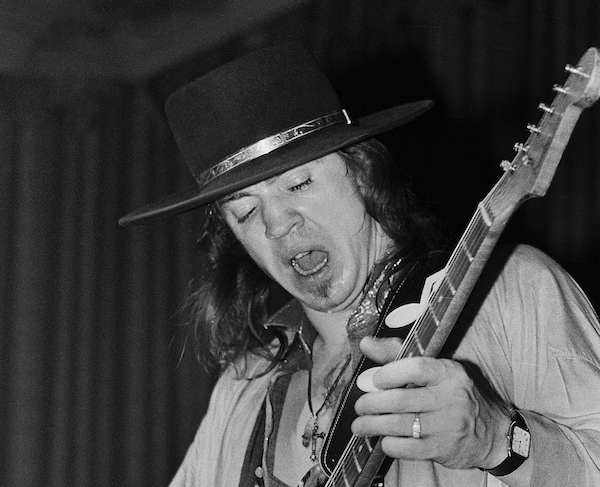Oct 28, 2025 10:47 AM
In Memoriam: Jack DeJohnette, 1942–2025
Jack DeJohnette, a bold and resourceful drummer and NEA Jazz Master who forged a unique vocabulary on the kit over his…

A new biography of blues guitarist-singer Stevie Ray Vaughan is titled after his 1983 album, Texas Flood.
(Photo: ©Paul Natkin/Photo Reserve, Inc.)What made Stevie Ray Vaughan great? Nearly 30 years after the Texas guitar slinger’s tragic death, music journalists Alan Paul and Andy Aledort provide hundreds of testimonials to his exalted status with Texas Flood: The Inside Story of Stevie Ray Vaughan (St. Martin’s Press). Paul recently described the 366-page book as “a biography in the form of an oral history.” The biographers, who are both musicians, brought rare insight to the project.
Scores of Vaughan’s bandmates and fellow Lone Star artists shared their stories for Texas Flood, most notably older brother Jimmie Vaughan, who served as Stevie’s guide into the music world. Jimmie—founder of the blues-rock band The Fabulous Thunderbirds and now a solo artist—previously had been reluctant to discuss his brother. But here, he details Stevie’s early guitar prowess and later triumphs.
Bassist Tommy Shannon and drummer Chris Layton, both longtime members of Vaughan’s trio, Double Trouble, offer valuable perspectives. But amid the many revealing quotes, one source seems a little scarce: Stevie himself. Aledort said he interviewed Vaughan on four occasions and knew him well, while Paul lamented that he never got a chance to interview him.
“Every quote in the book came from interviews that one of us conducted,” Paul explained. “It was tempting at times [to incorporate Vaughan quotes from secondary sources], but we thought it was important to stick with quotes from us.”
One nonparticipant was Johnny Winter (1944–2014), the prototypical white Texas blues-rock guitar hero, whose legacy slowly has faded as Vaughan’s reputation has continued to grow. “Johnny didn’t have a lot to say about Stevie,” Aledort said. Shannon, who played bass for Winter early in his career, provides needed context here.
The book is illustrated with two glossy sections of rare photos, as well as grainy black-and-white shots that break up the text. The authors present a balanced, warts-and-all account of Vaughan’s life without devolving into hagiography. Readers won’t like the substance-abusing SRV whose life spirals out of control prior to entering rehab in late 1986.
“Stevie’s life was so much about overcoming adversity, so the last several years of his life were dedicated to helping other people overcome their own adversity,” Paul said.
Aledort stressed that Vaughan’s intensity made him an enduring artist. “All things that are great just get better over time,” he said. “With Stevie, he combined two things that the greatest of the great usually do: He had tremendous facility and technique, but also played with a depth of emotion. Tommy Shannon said he poured his life into every note, and that sounds like a cliché, but it’s true.”
Bonnie Raitt, one of many rock stars who sing Vaughan’s praises in Texas Flood, said, “[T]he fire and passion with which he invested everything he touched was just astounding, as was the way he synthesized his influences and turned them into something so fiercely personal.”
As perhaps Vaughan’s foremost influence, blues legend Albert King said succinctly, “No doubt about it, Stevie had what it takes.”
In show business, a sudden death can enhance a legend. When Vaughan’s helicopter went down in the fog after a memorable show with Eric Clapton, Buddy Guy and Robert Cray at Alpine Valley in East Troy, Wisconsin, on Aug. 26, 1990, he was only 35 years old. He was at his creative peak, committed to sobriety, in a loving relationship and had recorded Family Style, a collaborative album with Jimmie.
Those who knew him best still marvel at his upbeat attitude and soaring musicianship. “Stevie’s tragic death only punctuates his greatness and puts a mark on his legacy, akin to Buddy Holly, Otis Redding, Jimi Hendrix, Janis Joplin and Duane Allman,” Layton said. “It’s like something has been stolen and you can only wonder what might have come next.”
Texas Flood will leave readers longing for that next chapter. DB

Jack DeJohnette boasted a musical resume that was as long as it was fearsome.
Oct 28, 2025 10:47 AM
Jack DeJohnette, a bold and resourceful drummer and NEA Jazz Master who forged a unique vocabulary on the kit over his…

Always a sharp dresser, Farnsworth wears a pocket square given to him by trumpeter Art Farmer. “You need to look good if you want to hang around me,” Farmer told him.
Sep 23, 2025 11:12 AM
When he was 12 years old, the hard-swinging veteran drummer Joe Farnsworth had a fateful encounter with his idol Max…

D’Angelo achieved commercial and critical success experimenting with a fusion of jazz, funk, soul, R&B and hip-hop.
Oct 14, 2025 1:47 PM
D’Angelo, a Grammy-winning R&B and neo-soul singer, guitarist and pianist who exerted a profound influence on 21st…

Kandace Springs channeled Shirley Horn’s deliberate phrasing and sublime self-accompaniment during her set at this year’s Pittsburgh International Jazz Festival.
Sep 30, 2025 12:28 PM
Janis Burley, the Pittsburgh International Jazz Festival’s founder and artistic director, did not, as might be…

Jim McNeely’s singular body of work had a profound and lasting influence on many of today’s top jazz composers in the U.S. and in Europe.
Oct 7, 2025 3:40 PM
Pianist Jim McNeely, one of the most distinguished large ensemble jazz composers of his generation, died Sept. 26 at…